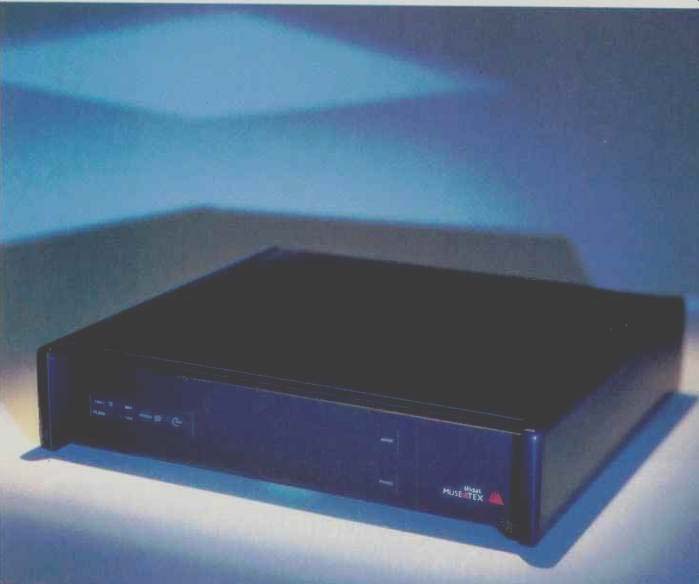
The Museatex Bidat D/A converter is the result of more than eight years of
effort by Ed Meitner and his design team, whose work I admire for its originality
and uniqueness. Since my last review of Meitner's equipment (the PA-6i preamp,
November 1988), Museatex has merged with a/d/s/, with Ed Meitner serving
as Vice President of Research and Development.
Inputs on the Bidat's rear panel are ST (AT&T glass), S/P DIF coax, AES/EBU balanced, and Toslink, allowing connection to all standard digital equipment. For analog outputs, the Bidat has a set of balanced XLR connectors and a pair of unbalanced out puts via high-quality phono connectors. A DIN connector, labeled "Option," is provided for connection to the optional wired remote control. Since the Bidat is partially a computer and occasionally may need resetting, a reset button is located on the rear panel, just below the DIN connector. A power on/off switch and IEC line-cord socket are stacked vertically at the right hand edge of the rear panel.
A removable metal plate on the bottom of the Bidat provides access to a DIP switch that selects which input and absolute polarity the unit will default to when it powers up, and whether the remote-control input will be active or not.
The only controls visible on the Bidat's front panel are two flush-mounted push button switches at the far right; these push buttons control input selection and absolute output polarity. The display, to the left of center on the panel, indicates which input is selected, the absolute-polarity state, and whether the unit is locked onto an in put signal. The display lights are a very appealing blue.
The optional remote only controls volume, by varying the reference voltages at the D/A converter. Museatex says this does not degrade digital resolution, as a conventional digital volume control would.
Two technical features set the Bidat apart from other D/A converters. First, it has a proprietary data receiver arrangement, called C-Lock by Museatex. Second, and equally (if not more) intriguing, is the use of a signal-adaptive digital oversampling filter. Both of these techniques are patented.
Ed Meitner has also patented a number of the other digital signal-processing concepts used in the Bidat and elsewhere--including the common practice of reclocking the clock signals applied to a DAC in an external D/A converter or within the digital electronics in a CD player.
=========
SPECS
Freq. Response: 20 Hz to 20 kHz, +0,-0.5 dB.
THD + N: -90 dB.
Noise: Better than -90 dB from 0 to 30 kHz, via optical or electrical inputs.
Jitter: Less than 10 uS, with no periodicity.
Interchannel Level Matching: Within 0.1 dB.
Digital Filtering: Eight-times over-sampling.
Inputs: ST glass optical, Toslink optical, 75-ohm coaxial, and AES/EBU balanced.
Output Impedances: Balanced, 600 ohms; unbalanced, 300 ohms.
Output Level: Maximum, 3.5 V rms.
Dimensions: 14 1/2 in. W x 3 in. H x 13 1/2 in. D (36.8 cm x 7.6 cm x 34.3 cm).
Weight: 17 lbs. (7.7 kg).
Price: $1,999; wired remote volume control, $399.
Company Address: c/o a/d/s/, One Progress Way, Wilmington, Mass. 01887.
========
Circuit Description
The unusual and elegant qualities of the Bidat's circuitry show up right at the input selector. Each input path uses two 74HC series inverters to square up the received signal. Instead of the usual signal-selector IC, the Bidat uses combinational logic, in which 74HC-series "OR" gates select the input signal to pass on to the subsequent circuitry. If an optical input is selected, only its optical receiver is powered up, while any wired input (coax or AES/EBU) that is not selected has its input pulled low by a shunt transistor. The selected signal is passed on to the input receiver and C-Lock circuitry.
The C-Lock input receiver derives its clock signal in an equally original way. In the conventional approach, a phase-locked loop (PLL) in the input receiver generates a clock signal at a multiple of the input data rate-typically 64 times the sampling frequency (64fs), or 2.8224 MHz for CD. In order to lock reliably onto the input signal, this PLL usually has a wide bandwidth of about 20 kHz or so. This bandwidth allows any audio-frequency jitter in the incoming signal to pass right on through to the clock signals generated by the input receiver. The better D/A converters use a secondary PLL, with a low bandwidth, to further process the receiver's clock-signal outputs before delivery to the DAC circuitry, since it is at the DAC that jitter can manifest itself as distortion in the recovered audio signal.
In the C-Lock approach, a signal at twice the sampling frequency is derived directly from the incoming S/P DIF data stream without using a PLL circuit. This 2fs signal, unlike the PLL-derived conventional clock signal, isn't affected by edge jitter in the audio data portion of the input signal. This is because the detection of the 2fs signal is at the beginning of each audio frame, in what is called the preamble section, away from the frame's audio data. The derived 2fs signal is fed to a PLL circuit having a low jitter-cutoff frequency of about 10 Hz. In this PLL, a voltage-controlled crystal oscillator (VCXO) generates a master clock signal at 384f, which is divided down to 2fs for comparison in the PLL's phase detector. (Other needed clock frequencies are de rived by suitable division of the master clock.) An input receiver is utilized in the Bidat to generate the output data format and clock signals needed by the following digital filter. The input to the receiver is the selected signal. In this arrangement, however, the receiver is fed the stable clock signal from the aforementioned PLL instead of using its own, internally generated, clock signal.
Data and clock outputs of the receiver are routed to the digital filter section, which (as alluded to above) is an intelligent signal-adaptive system. Two custom Motorola DSP56001 DSP devices are utilized, one per channel. Two digital filters are generated by each DSP, one optimized for best transient response, the other for flattest frequency response with maxi mum out-of-band attenuation. A discontinuity detector scans the digital audio data ahead of the eight-times-oversampling interpolation filter If a transient pulse is detected, output data is taken from the transient-optimized filter, during a windowed timeout relating to the length of the transient. If no transient is detected, the flat-response filter is selected. If a transient occurs while data is being taken from the transient-optimized filter, the window time is restarted.
Data output of the digital filter section is applied to the input of the DAC circuitry. The Bidat utilizes a Philips SAA7350 and TDA1547 together to form a very high-quality, one-bit DAC system.
A pair of one-bit data streams and a clock signal couple the output of the SAA7350 (which is used, alone, as a one-bit DAC in a number of D/A converters) into the input of the TDA1547. The TDA1547 then performs the switched-capacitor filtering that produces the analog output voltage. Because the clock signal going into the TDA1547 is the critical one, as far as possible contamination of the final audio output is concerned, both one-bit data lines (left and right) and the clock signal are reclocked with separate flip-flops before entering the TDA1547. The reclocking signal for the flip-flops comes from the master VCXO in the input/receiver circuitry's phase-locked loop.
Audio outputs of the TDA1547 are in differential form. Separate output amplifiers, which also function as third-order multiple-feedback low-pass filters, amplify each output phase from the TDA1547 and drive the XLR balanced output connector.
The balanced outputs also drive the RCA unbalanced output jack, via another output amplifier which converts the differential signal to a single-ended one. (These output amplifiers are all AD845 op-amps.) From a purist point of view, this would make the balanced outputs a better choice (if the following equipment has balanced inputs), since they have one fewer amplifier in their signal path.
The output circuitry includes several bits of analog sorcery. The capacitors in the output amplifier's filter network (small film capacitors, not electrolytics) are biased with a d.c. voltage to improve their "sound." Each output amplifier has a constant current source connected from its output to the negative supply rail, to improve output-stage linearity. Servo op-amp integrators are connected from the balanced main amplifier outputs back to their respective noninverting in puts through a voltage divider.
This arrangement reduces d.c. offset to negligible values.
Two power transformers are used in the Bidat, one for digital and one for analog circuitry. In the analog supply, separate secondary windings are full-wave bridge rectified to feed the voltage regulators that produce +14 and -14 V d.c. These voltage regulators each consist of a zener follower circuit, with the zener diodes fed from a constant current source. Separate trans former windings are used in the digital supply and are full-wave bridge rectified and applied to several voltage regulators. One supply feeds +15 V to the PLL and C-Lock circuits that use this voltage. The other supply has two main voltage regulators; one powers the DSP circuitry while the other powers the input receiver, PLL, and DAC. The digital and analog sections of the TDA1547 switched-capacitor filter in the DAC each get their +5 and -5 V requirements by local regulators fed from the analog supply's output of +14 and -14 V.
Measurements
Output voltages at digital full scale (0 dBfs) were 3.21 V for the left channel and 3.19 V for the right, via the unbalanced out puts, while the balanced-output voltages were 3.20 and 3.19 V, respectively. Output impedances were 300 ohms in unbalanced mode and 600 ohms in balanced mode.
Subsequent tests were all run via the unbalanced outputs, unless otherwise noted, as the results from the balanced outputs were essentially the same.
Frequency response at 0 dBfs, with and without de-emphasis, is plotted in Fig. 1.
The response with de-emphasis has been displaced upwards by 0.5 dB for clarity; it rolls off the highs a little more than the nor mal response, without de-emphasis.
Figure 2 shows the superior transient response of the adaptive digital filter when handling a transient signal, such as a squarewave. I have also seen unusually low square-wave ringing in Krell and Wadia D/A converters, whose digital filter algorithms favored time-domain behavior. However, these converters had quite high harmonic distortion readings as the test frequency approached 20 kHz, due to inadequate rejection of aliasing frequencies. Nothing that I have seen comes close to the square-wave fidelity of the Bidat. Further, as we shall shortly see, there is no harmonic-distortion rise near the upper end of the audio range.
Total harmonic distortion plus noise (THD + N) versus frequency, at digital full scale and with a 22-kHz measurement bandwidth, is shown in Fig. 3, and THD + N as a function of digital signal level is plot ted in Fig. 4 for a 1-kHz test tone. These distortion results are all very good. Continuing on the subject of linearity, note in Fig. 5 the superb input/output linearity of the Bidat for input signals in the range of -60 to -120 dBfs at 1 kHz. In the noise-modulation test (not shown), a 40-Hz signal was presented at input levels of -60, -70, -80, -90, and -100 dBfs and the output was measured by sweeping a third-octave filter from 300 Hz to 20 kHz. All the traces essentially overlaid each other-excellent behavior.
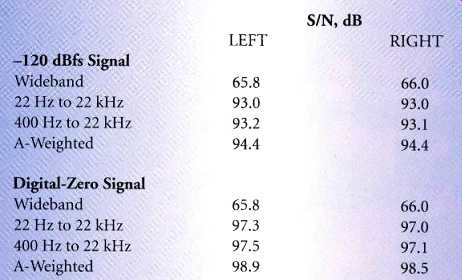
Table I--Signal-to-noise ratios. Quantization noise was-92.7 dB for channel
and-93.4 for the right channel; dynamic range was 95.7 dB for either channel.
Interchannel crosstalk, both with unbalanced and balanced outputs, was better than -110 dB up to 1 kHz, rising slightly to about -93 dB at 20 kHz at the unbalanced outputs and about -103 dB at the balanced ones. Crosstalk was very similar in both directions, for either output.
Quantization noise, dynamic range, and S/N are presented in Table I. These numbers are very good and better than I have seen from most one-bit D/A converters. With wideband measurement, S/N is lower than when measured only in the audio band, due to high-frequency noise above that band; this noise is caused by the noise-shaping process inherent in one-bit converters. The in-band measurements with a digital-zero signal are not as good as those attainable with good multibit D/A converters.
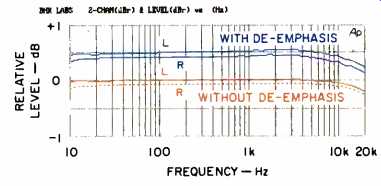
Fig. 1--Frequency response; curve with de-emphasis offset 0.5 dB for clarity.
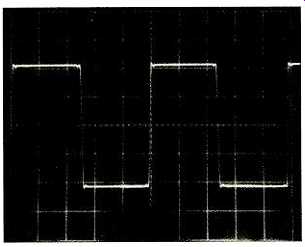
Fig. 2--Square-wave response at 1 kHz.
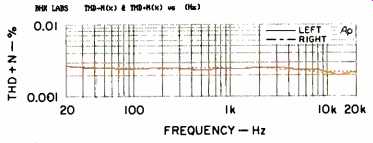
Fig. 3--THD + N vs. frequency a 0 dBfs.
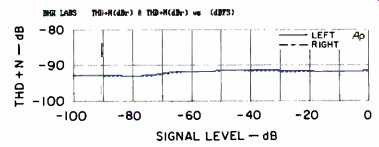
Fig. 4--THD + N vs. signal amplitude at 1 kHz.
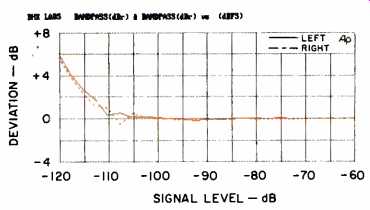
Fig. 5--Devation from linearity, for 1-kHz signal.
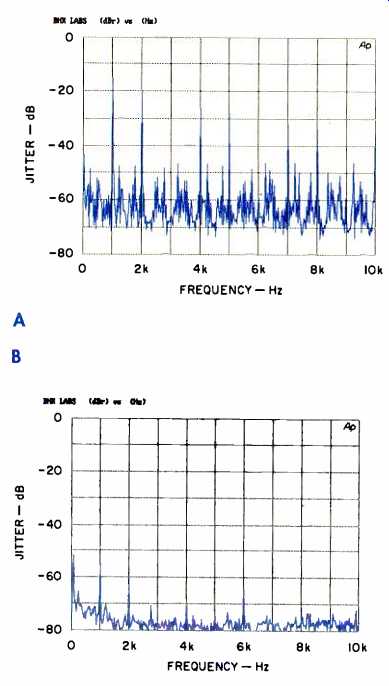
Fig. 6--Spectrum of jitter in S/PDIF signal from CD player/transport (A)
and in 8fs left/right clock at input to DAC (B).
Figures 6A and 6B show how effective the C-Lock circuit is in removing jitter from the incoming S/PDIF signal. Figure 6A shows a spectrum of the jitter on the S/PDIF signal at the digital output of a Philips CD921 CD player, a relatively new design.
(This curve may look pretty bad, but it is typical of a lot of CD players used as CD transports, which tend to use undersized, poorly designed, digital-output isolation transformers. Good CD transports have a lot less jitter under these conditions--more like 40 to 50 dB down in a measurement such as the one in Fig. 6A.) The audio signal itself was a 1-kHz, -90 dB, undithered signal from the Columbia CD-1 test disc. Note how much of the spectrum is signal-correlated! Most of the other discrete frequencies in the spectrum are harmonics of the signal frequency or intermodulation products of the signal with the block rate of the S/PDIF data (1/192 of the sampling frequency, or about 230 Hz). The fundamental jitter component, at 1 kHz, is about 1.68 nS, peak to peak, or 594 pS rms. (Full scale on these plots is 10 nS, peak to peak.) This data was taken with a jitter detector of my own de sign, which is as sensitive as a DAC to all the jitter in the data (digital audio) area of the S/PDIF subframes.
Figure 6B, by contrast, shows how much less jitter is present in the C-Lock-derived, 8fs, left/right clock signal driving the Philips SAA7350 DAC chip when the Bidat is fed the signal shown in Fig. 6A. (This data was taken with a Meitner LIM Detector, which was loaned to me for this review; however, the results using my own detector were essentially the same.) Note that a jitter component of -60 dB would represent 10 pS, peak to peak, or 3.54 pS rms. Those D/A converters that don't have secondary PLLs to reduce jitter would have the jitter spectrum of Fig. 6A superimposed on all of the recovered clock signals if this particular CD player/transport were used. This could, in my opinion, have an audible effect on the recovered audio.
A few final measurement comments: The d.c. offset at all output terminals was 1 mV or less, absolute polarity was correct as indicated, and a.c. line draw was 200 mA.
Use and Listening Tests
Phono equipment used in my system during the review period included an Oracle Audio turntable fitted with a Well Tempered Arm and a Stanton 981HZS moving-magnet pickup, feeding my own tube phono preamp/passive signal selector/attenuator or a Quicksilver Audio preamp.
Counterpoint DA-11A and PS Audio Lambda CD transports were used to drive the Bidat, a Sonic Frontiers SFD-2 MKII, and some experimental D/A converters.
Other signal sources included a Nakamichi ST-7 FM tuner and 250 cassette recorder and a Technics open-reel recorder. Preamplifiers used included a Quicksilver Audio, Forssell tube line drivers, a First Sound II passive model, and my own passive signal selector/attenuator. Power amplifiers used were a Crown Macro Reference, Quicksilver M135s, and a Counterpoint NPS-400A hybrid unit. The loudspeakers were B & W 801 Matrix Series 3s, augmented in the range from 20 to 50 Hz by my subwoofer systems, each using a JBL 1400Nd driver in a 5-cubic-foot ported enclosure.
When I got the Bidat warmed up and playing in my system, my first impression was that it was a very good-sounding D/A converter. After measuring it, I again set it up and my initial impression was con firmed. This unit is one I can listen to and enjoy music with. It has good definition with low irritation. Tonal balance seems just a bit laid back, with space and dimension a little foreshortened compared to other converters I have. Bass quality, definition, and "slam" are very good. Compared to the very best setup I've had going recently, and admittedly this is one that costs nearly three times as much as the Bidat, the sound with the Bidat was less clear, more subdued, and not quite so musically convincing.
All in all, though, the Bidat sounded quite good to me and I surely enjoyed my experience with it. It operated flawlessly, in the lab and in my system. Go give this unit a listen.
-BASCOM H. KING
(Audio magazine, Nov. 1995)
Also see:
Muse Electronics Model Two D/A Converter (Auricle; Jan. 1996)
Assemblage DAC-1 D/A Converter Kit (Nov. 1995)
Philips DAC960 D/A converter (Jun. 1988)
= = = =